THE CITY BAND LEGACY
RANDY KIDD’S
LAST TO-DO LIST


THE CITY BAND LEGACY
RANDY KIDD’S
LAST TO-DO LIST


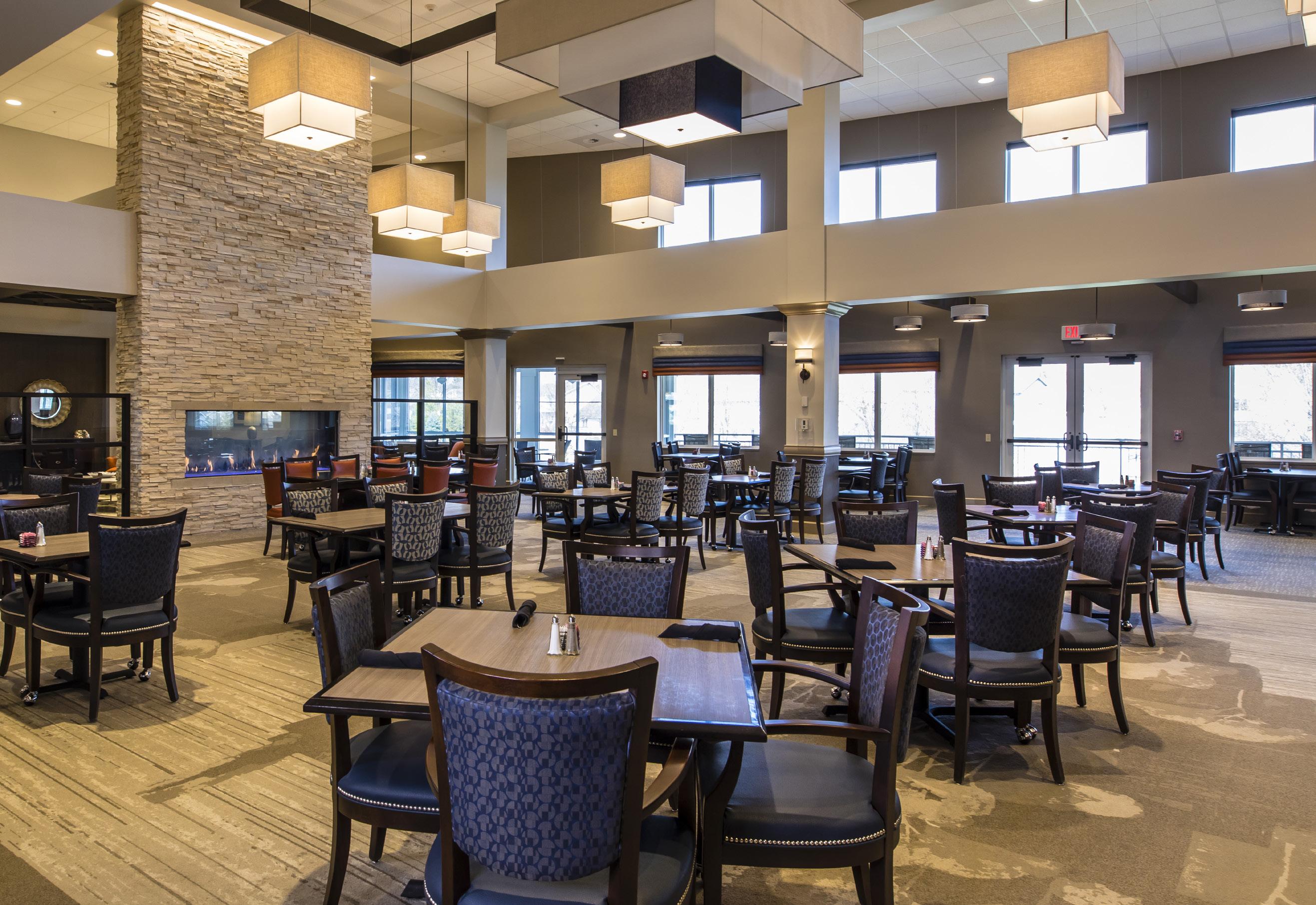
and

For nearly 40 years, Lawrence Otolaryngology has been treating patients of all ages. We are proud to be your hometown ENT provider specializing in the care and treatment of the head, neck and face. We offer one of the largest selections of hearing aids & accessories in our area and provide hearing screenings and diagnostic testing for patients of all ages. We serve our patients with the time and attention it takes to truly make a difference in your health journey.
& Nonsurgical Treatment of Thyroid & Parathyroid Disorders Facial Injury Repair Speech Evaluations & Speech and Voice Therapy

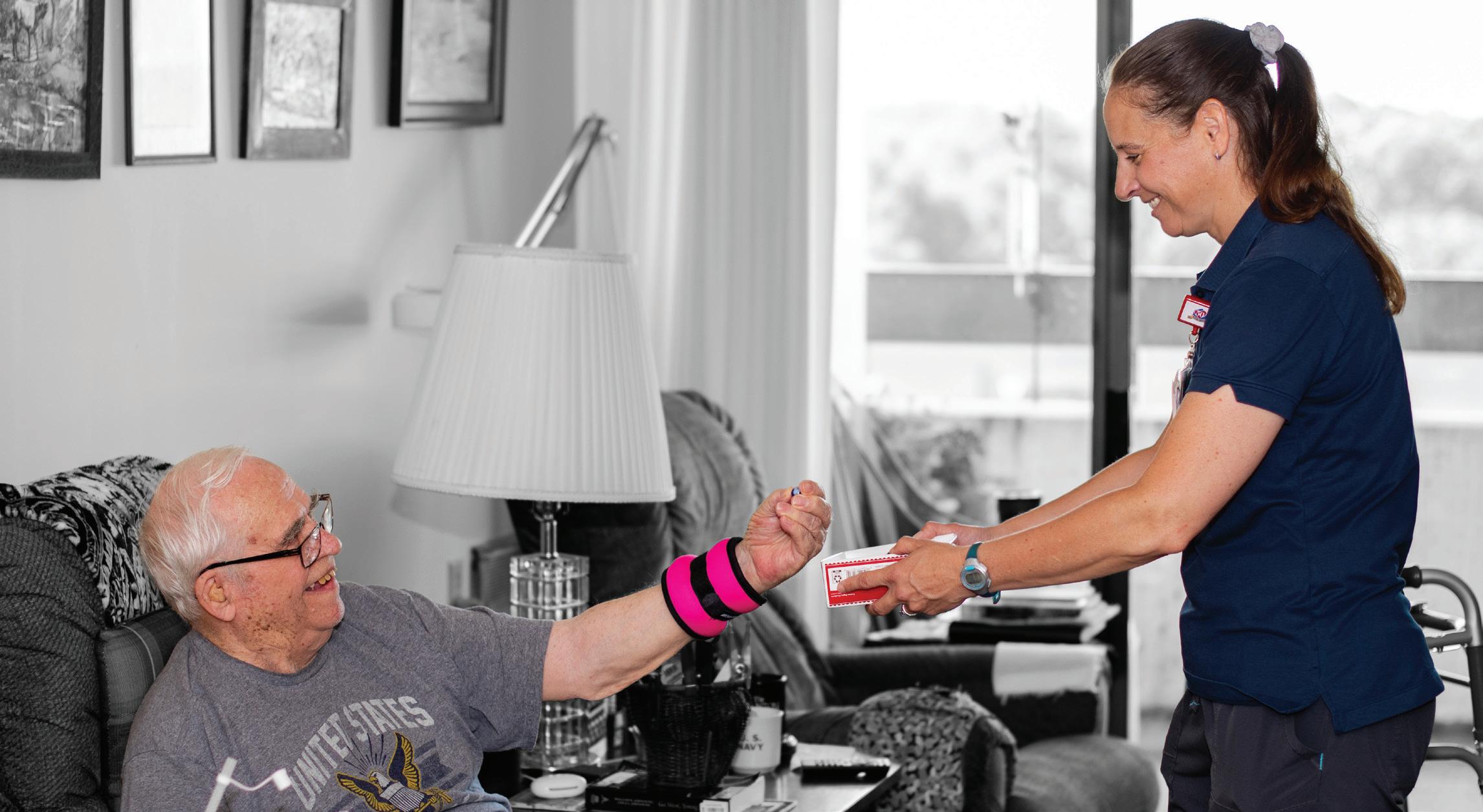












Board Certified Ophthalmologist
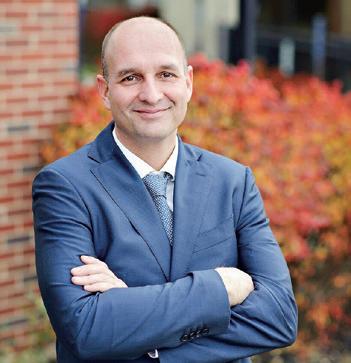
Board Certified Ophthalmologist
Dr. Hickman specializes in:
Dr. Hickman specializes in:
Board Certified Ophthalmologist
• Traditional and laser cataract surgery including premium lenses
• Age-related macular degeneration
• Traditional and laser cataract surgery including premium lenses
• Glaucoma management and surgery
Dr. Hickman specializes in:
• Age-related macular degeneration
• Diabetic retinopathy
• Glaucoma management and surgery
• Diabetic retinopathy
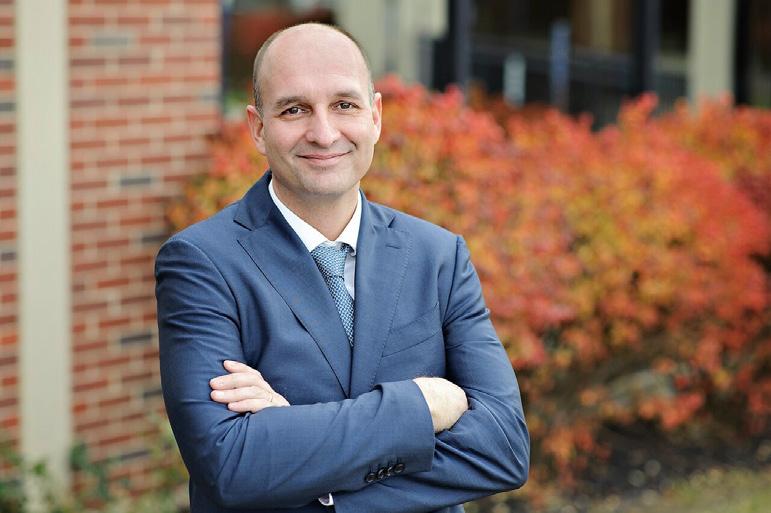
• Comprehensive eye exams
Dr. Hickman specializes in:
• Traditional and laser cataract surgery including premium lenses
• Pterygium surgery
• Comprehensive eye exams
• Pterygium surgery
• Traditional and laser cataract surgery including premium lenses
• Age-related macular degeneration
• Glaucoma management and surgery
• Diabetic retinopathy
• Age-related macular degeneration
• Comprehensive eye exams
• Diabetic retinopathy
Ad Astra Eye now offers Selective Laser Trabeculoplasty (SLT) procedure in the comfort of our own office with the Ellex Tango SLT/YAG laser—the #1 SLT/YAG in the U.S. as part of the comprehensive care for glaucoma patients.
• Glaucoma management and surgery
• Pterygium surgery
• Comprehensive eye exams
• Pterygium surgery
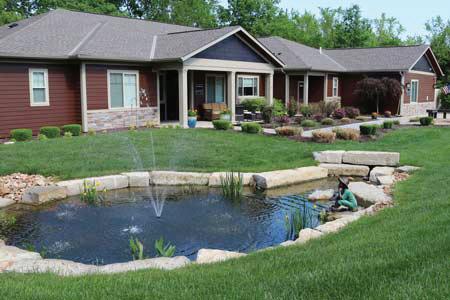




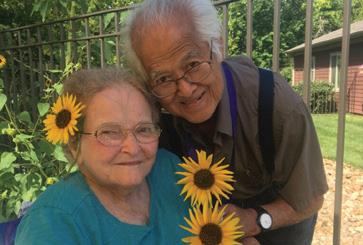






EDITOR
Nathan Pettengill
ART DIRECTOR
Alex Tatro
ADVERTISING EXECUTIVE
Joanne Morgan jmorgan@sunflowerpub.com
785.832.7264
COPY EDITOR
Leslie Clugston Andres
WRITERS
Amber Fraley
Darin M. White
PHOTOGRAPHERS
Jason Dailey
DIRECTOR
Bob Cucciniello
PUBLISHER
Bill Uhler
Norman Gee sits in front of one of his paintings at his home studio in Lawrence. Photograph by Jason Dailey.
Welcome to the annual Lawrence Senior + Health magazine, a sister publication of Lawrence Magazine.
This year’s edition brings three stories of how the interests and passions we pursue shape us and remain with us.
Perhaps (as is the case for the subjects in our three main stories) it is art, music, or nature that gives meaning to your life. Or perhaps it is something else. Whatever fulfills you, we hope you enjoy doing what you love all through your life.
Until next year, Nathan Pettengill, editor
Lawrence artist Norman Gee creates a new series of art in his 80s
Retired musicians join mid-career professionals and even a few youngsters to keep one of Lawrence’s oldest traditions alive
In his last years of life, a retired veterinarian focused on a final to-do list that included an account of his own mortality and his lifelong reverence for nature
Essential numbers and contact information for senior living in Douglas County

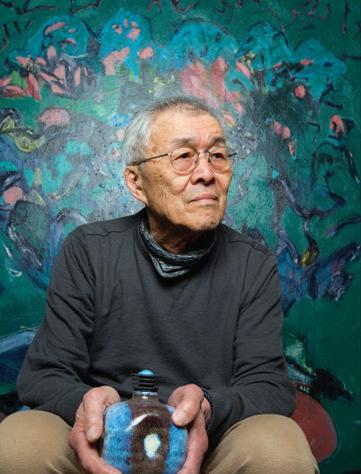
Lawrence Senior + Health is a special annual publication of Lawrence Magazine, part of Sunflower Publishing, a division of Ogden Publications.
Sunflower Publishing 1035 N. Third Street, Suite 101-B | Lawrence, KS 66044 (888) 497-8668 or (785) 832-7264 | sunflowerpub.com
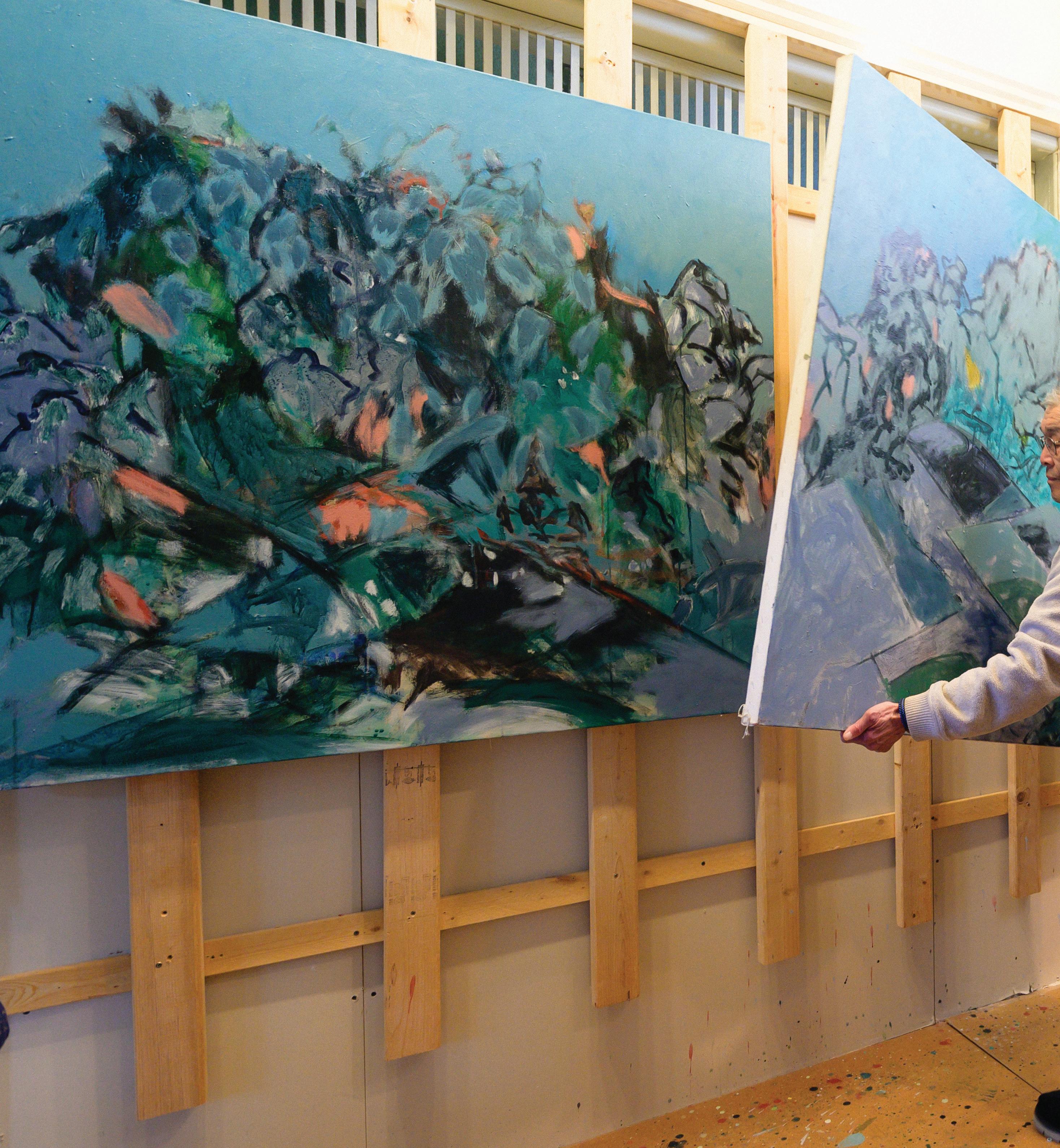

Art was not part of my growing up,” explains Norman Gee, a Lawrence resident and retired University of Kansas professor who creates paintings from his home studio in central Lawrence.
Gee is the son of working-class, first-generation Chinese immigrants from the Taishan region of China who came to the United States, worked various jobs, and opened their own restaurant in California’s San Joaquin Valley
Art didn’t become a possibility until Gee, then in his early 20s, visited an art studio by chance, toured the California College of Arts and Crafts (CCAC), and submitted his application.
Looking back, Gee says the submitted portfolio was fairly poor work. But he was accepted—with a scholarship.
The next few years transformed the trajectory of Gee’s life and shaped what he considers the eclectic style of art he continues to explore.
“I think back to my CCAC days, and there was so much I was exposed to that I could say everything around me could be considered part of my influences, even things I didn’t think much of at the time,” Gee explains.
In 1969, his work as an artist would soon take him far away, from the West Coast to Lawrence, where he had accepted a one-year appointment as an art professor while his wife, Helen, remained to live and work in California. One year later, Gee’s temporary position turned permanent, and Helen left her career to join him in Kansas.
He taught at KU for more than three decades, influencing generations of students and—as he notes— continuing to be a student himself.
“To be a viable artist, one must be learning constantly. Even in my 33 years teaching at KU, I was learning as I was teaching. It never ends,” Gee says.
Through his years of painting, Gee has created a body of work unbound by any particular style. His creations incorporate a wide range of influences, from classical Chinese ceramic patterns to landscapes and abstractions.
He often works on more than one painting at a time, and it is not uncommon for him to take a painting from his “finished” wall of paintings to rework or add various thoughts.
Throughout his career, Gee has sometimes put aside his art to care for family members. He was the primary caretaker for his mother for 15 years and also cared
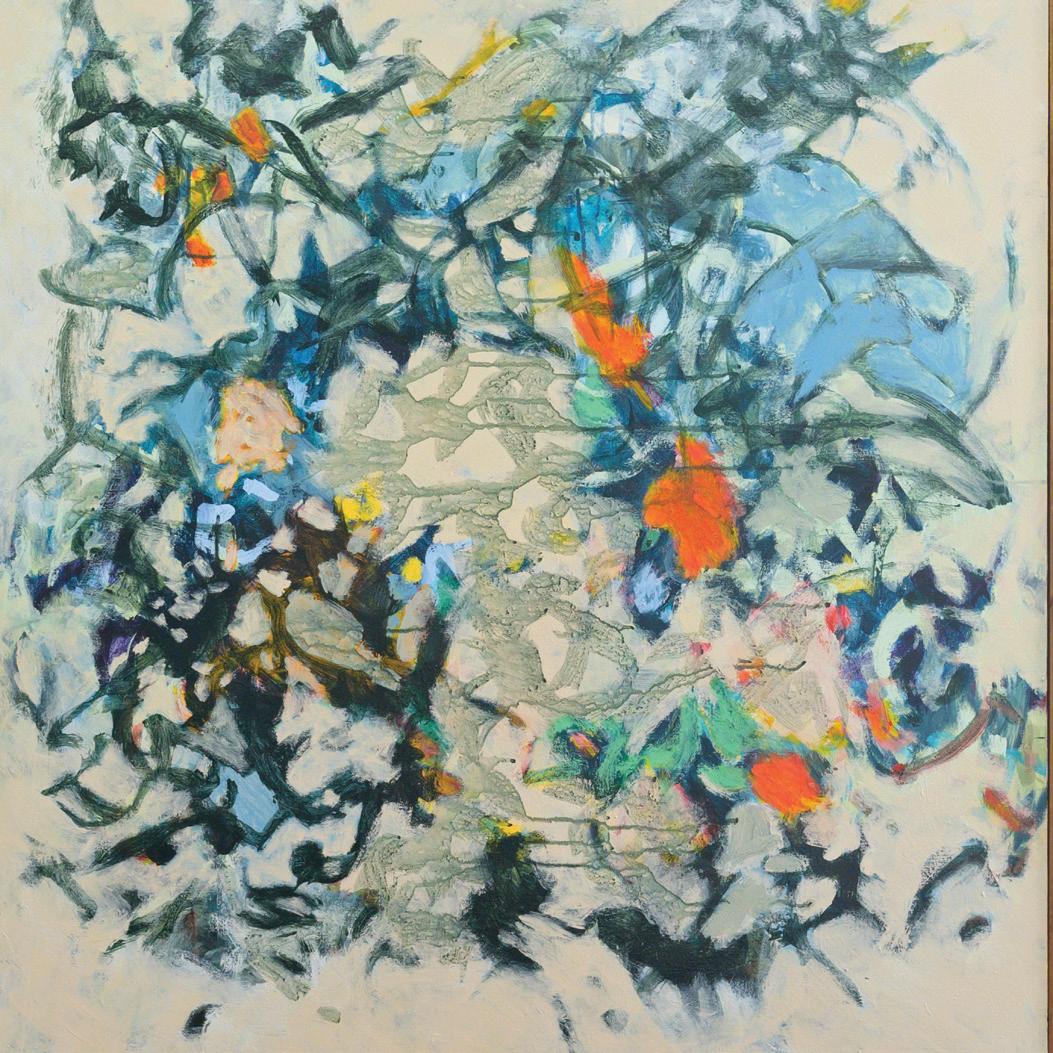

Gee often works on several projects at once, and he often returns to his previously completed works to add new elements.
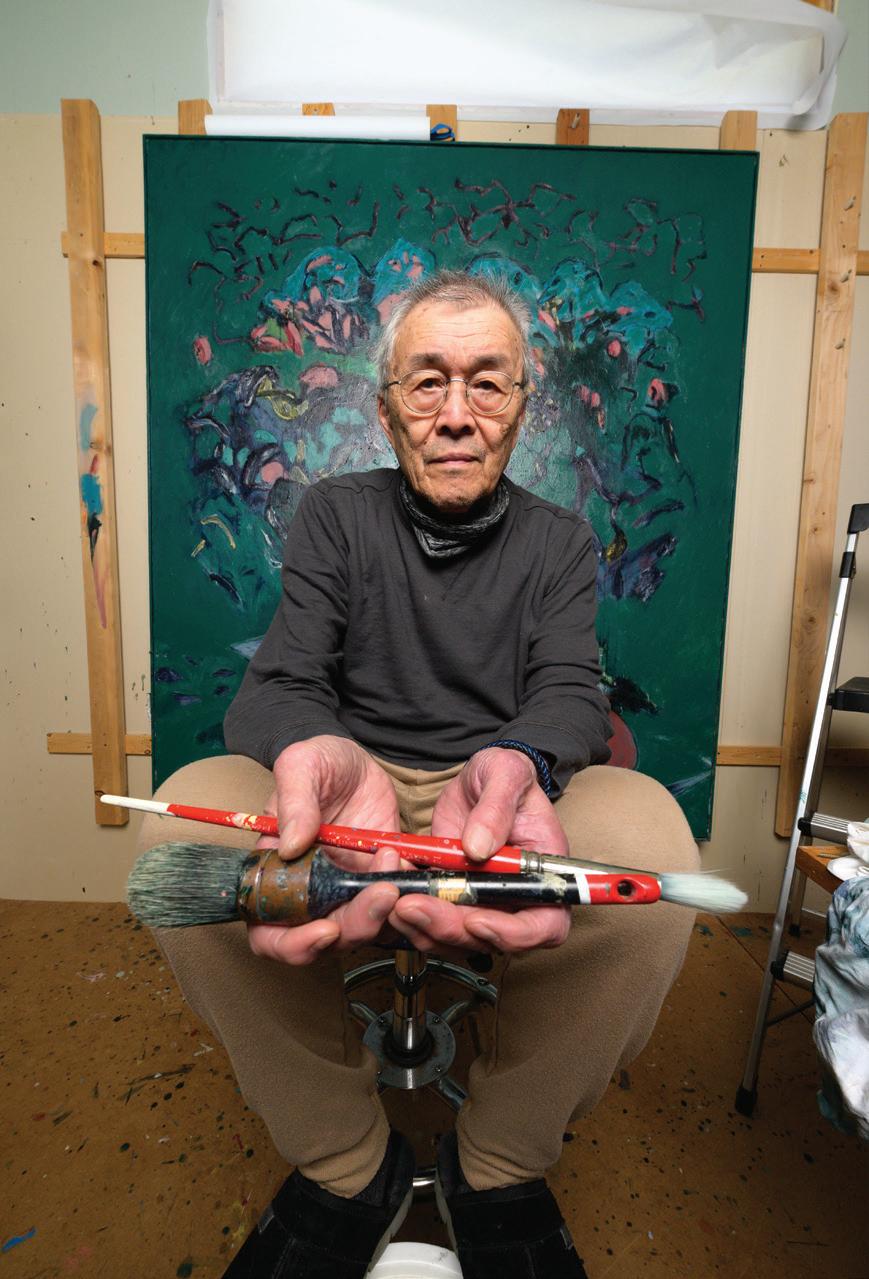


for his wife, who lived with Alzheimer’s for 10 years before she passed away in December 2023. They had been married for 57 years.
His work is highly appreciated by fellow artists and those who have seen and are familiar with it.
Gee’s paintings are collected by institutions such as KU’s Spencer Museum of Art and the United States Department of State, for its Art in Embassies program.
Gee’s latest creations are a series of green-bluethemed paintings of abstract flora or fauna elements with patches of coral colors popping out of the green-blue background and floating, cloud-like, over geometric patterns, as if it were a landscape viewed from a high elevation.
Like much of his previous work, these paintings have no titles. Gee describes the paintings only as evidence that he is still learning.
“It never ends,” he repeats. “What were influences became part of my subconscious, and it all contributes to my particular sensibility.”
This article was adapted from a story that originally appeared in the summer 2024 edition of Lawrence Magazine.

STORY BY Amber Fraley
BY Jason Dailey
Retired musicians join mid-career professionals and even a few youngsters to keep one of Lawrence’s oldest traditions alive
The first time Martin Burgee, conductor of the Lawrence City Band, played with the city band was in the mid-1980s while he was a doctoral student at the University of Kansas.
Then, there was a break for 20 years as he taught in Missouri.
“And then the mother ship called me home in 2007,” Burgee jokes, this time to teach music education at KU and play in the Lawrence City Band under conductor Robert Foster, “who was also my college band director and one of my favorite people ever,” Burgee notes.
That connection, from conductor to conductor, is part of a long and direct 170-year musical lineage as old as the city.
The original eight members of the Lawrence City Band moved to Lawrence and founded the group in the city’s founding year of 1854. Nearly a decade later, seeing the band’s battered old instruments, Kansas’ first governor, Charles Robinson, made sure the Lawrence City Band received new instruments and band uniforms. The band debuted the new gear in the middle of the Civil War on the evening of August 20, 1863, with a concert. The next day, Confederate guerrilla leader William Quantrill and his raiders would ride through Lawrence, killing nearly 200 people, as well as four of the eight band members.
But the city rebuilt, and the band reformed.
Nearly 100 years later, Foster moved to Lawrence in 1971 to be director of bands at the University of Kansas and began playing trumpet for the Lawrence City Band. He took over as the city band conductor in 1992 and led the group until 2015.
Foster says the Lawrence City Band is steeped in several decades-old traditions, such as starting concerts with the “Star Spangled Banner” and closing concerts with a John Philip Sousa march.

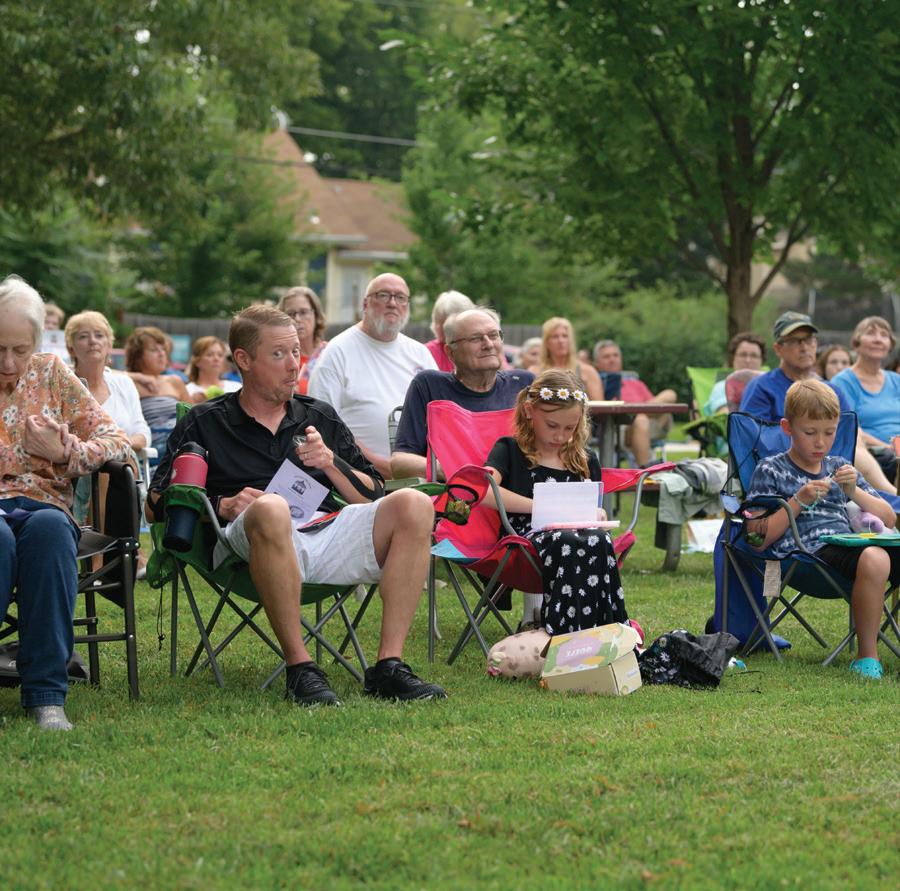
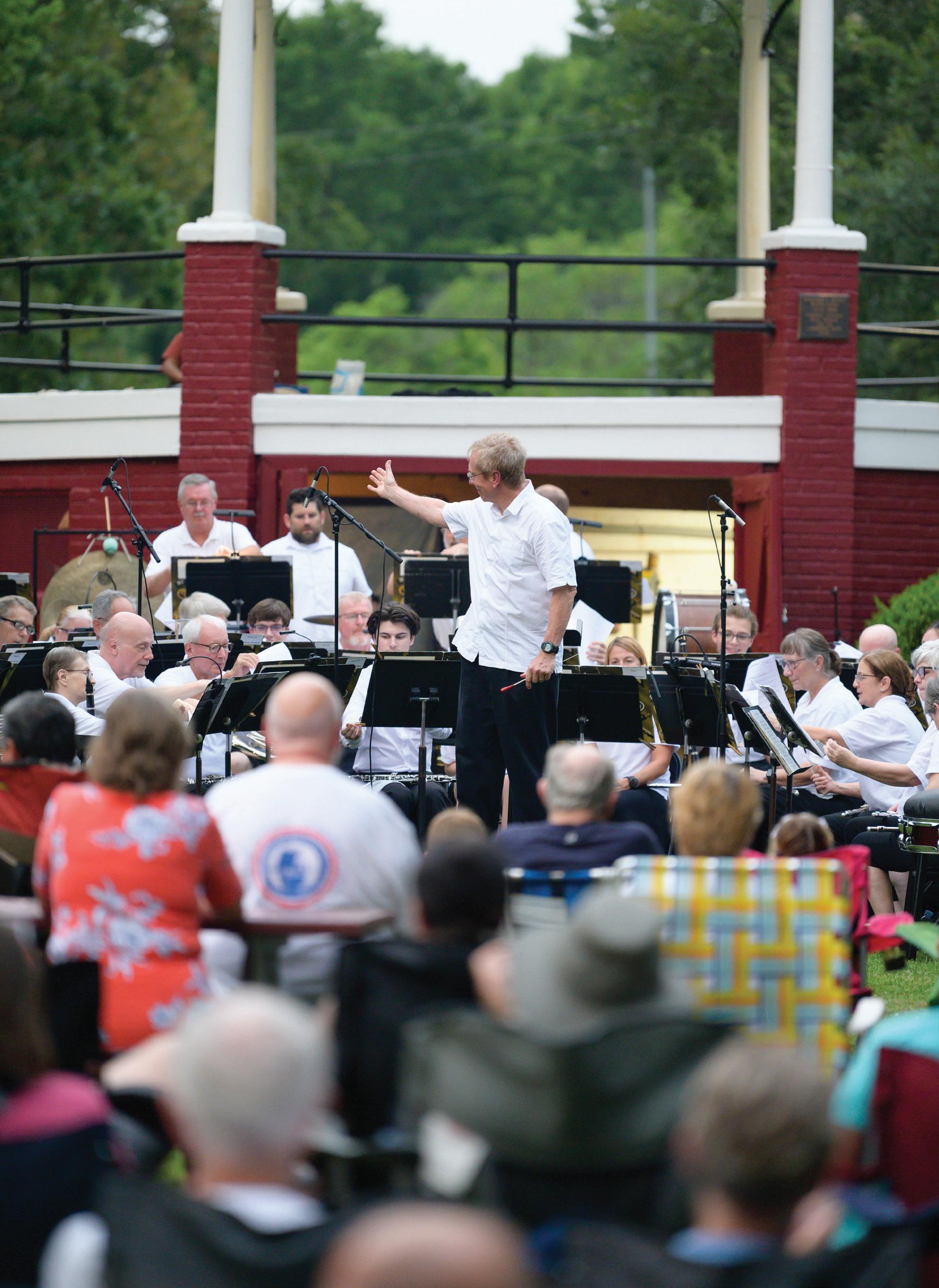

Playing music by local composers is also a tradition. “We have a lot of really excellent musicians and composers here in Lawrence, and we tried to perform their material as much as possible,” says Foster. “This is a very gifted community. That’s one reason it’s so fun here in Lawrence, Kansas.”
Though many city bands might be larger, Foster explains that the Lawrence City Band tradition has always been quality over quantity.
“I think the players in the group play in it because the group is really good,” says Burgee. “We do difficult, challenging music, and we have an hour to rehearse it for an hour-long performance that same day, so we have to be good.”
Burgee and Foster both give high praise to the City of Lawrence for supporting the band.
“Lawrence Parks and Rec sponsors those
concerts and does a great job—that’s one of the traditions of Lawrence, Kansas, is Parks and Recreation presenting the summer concerts on Wednesday nights at the park. It’s a great tradition,” says Foster.
And the tradition of passing the baton continues.
Burgee retired from teaching music education at KU in 2022 and today shares conducting responsibilities with Paul Popiel, dean of KU’s School of Music.
“He takes five concerts, and I take three,” Burgee explains.
Though Foster no longer conducts or plays with the City Band, he is a loyal audience member.
“I don’t miss concerts. We go to South Park on Wednesday nights and sit in lawn chairs and visit with nice people,” Foster says. “It’s like a little piece of Americana.”
This story is adapted from an article that appeared in the 2025 edition of DouglasCountyNewcomersGuide.


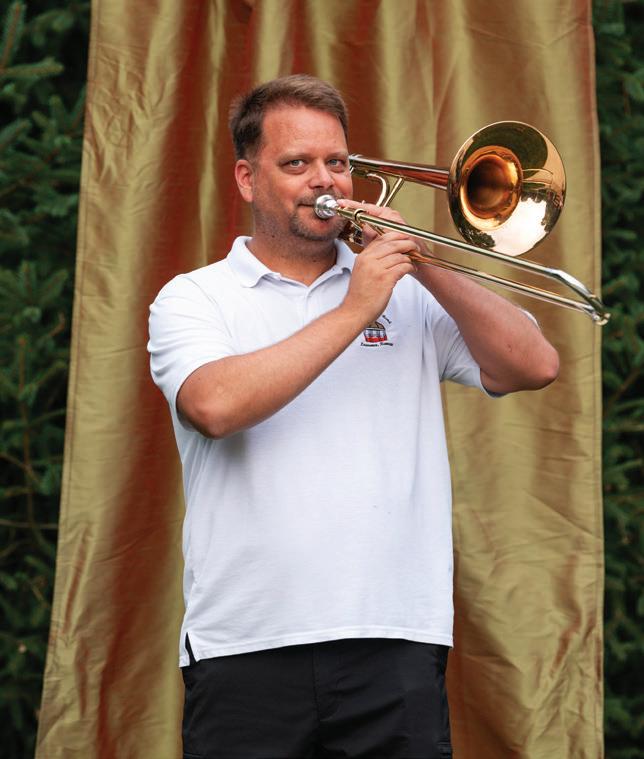
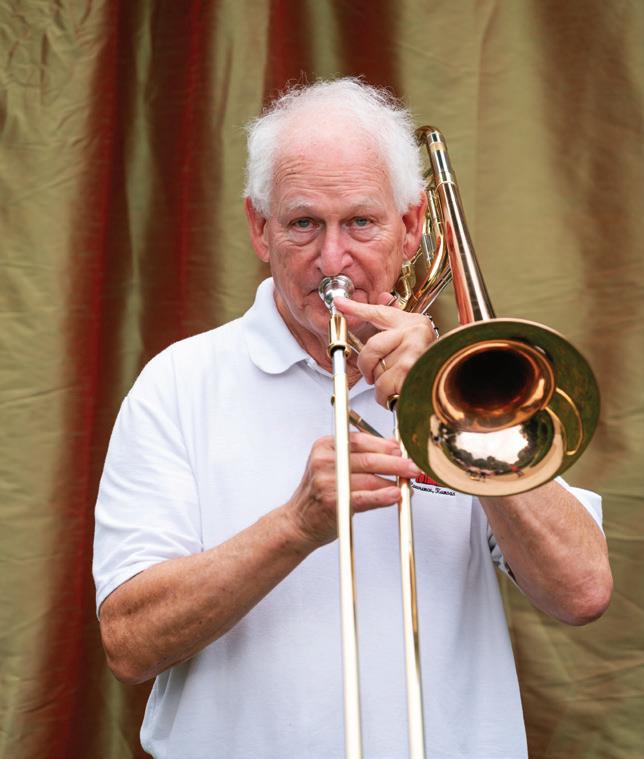



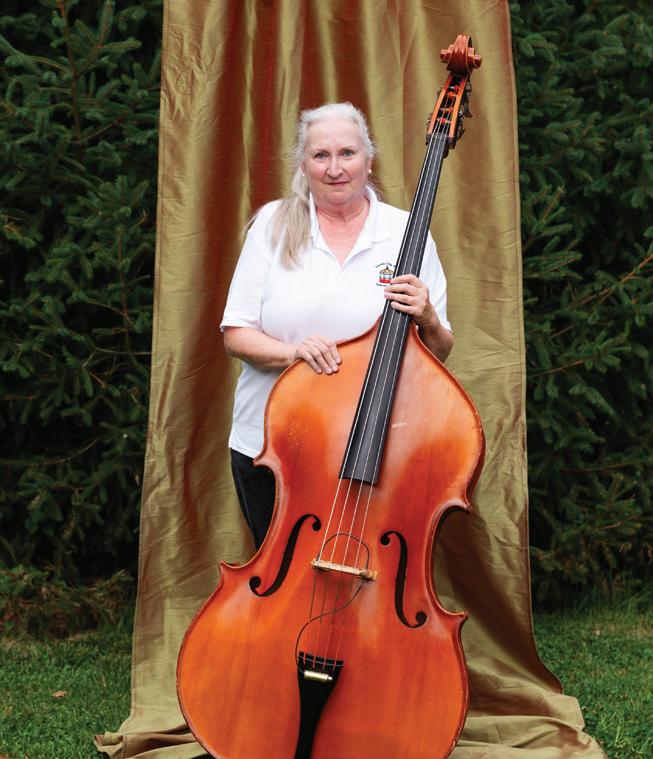
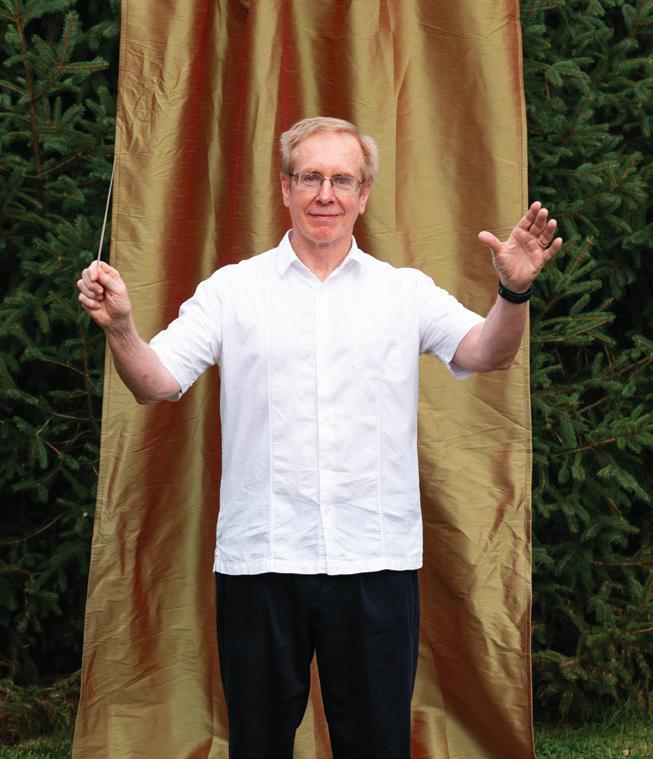
In his last years of life, a retired veterinarian focused on a final to-do list that included an account of his own mortality and his lifelong reverence for nature
After Randy Kidd was diagnosed with stage four prostate cancer in 2018, the Lawrence resident wrote down four end-of-life goals. He would walk every day, immerse himself in nature, honor his family, and he would “create something fantastic” with his writing.
Those who frequented the Sixth Street corridor between Folks and Queen’s roads or who explored the walking trails behind Rock Chalk Pavilion during the past years would have seen Kidd achieving his first two goals. He was that gray-bearded, baseball capwearing man with two walking sticks who strolled those areas’ sidewalks and trails until shortly before his death in January 2024.
His family will know of the love he gave them.
And now, with the release of Nature Walking with Cancer (Anamcara Press, 2024), Kidd has posthumously made good on the last goal of his list.
Nature Walking with Cancer reflects Kidd’s roaming and curiosity-driven trajectory in life—from a college football standout, to an airline pilot, to a homeopathic veterinarian. And it reflects a rigorous, scientific mind that is at times skeptical of profitinfluenced standards in the medical industry and continually intrigued by the power of nature, biology, spirituality, and inter-connectedness of creatures that he encountered during his years of observing and treating animals.
Though Kidd walked, wrote, loved, and endured through a post-diagnosis period longer than expected, his last years were not focused on metaphors of fighting cancer or beating back the disease. Instead, as he explains, he negotiated an acceptance of physical pain, mental exhaustion, and the good, clear days when he could focus on his last goals in life.
Kidd described completing his end-of-life to-do list as a “personal vehicle to help me return to my
inner-most thoughts back to love—back to the love of nature, to the love of family, and ultimately to the love of self.”
As Kidd traveled along his final paths, he recorded thoughts that drew equally on his expertise and his reverence for nature. This edited excerpt from Nature Walking with Cancer combines some of Kidd’s thoughts on disease, wisdom, mortality and squirrels.
The ambulance rocks right and left as we weave in and out of traffic; I am jolted wide awake as we brake and accelerate. My mind is still pondering the big question: How the hell did I get here?
I am released from my restraints and helped into a wheelchair.
I sit in my wheelchair, waiting in a long hallway, dank and sterilized of all color and feel—waiting for someonetoappearandwheelmeaway,someonethey have promised will appear soon.
I get the idea that dying from cancer is never the most graceful of ways to depart this world—lots of pain and suffering and humiliatingly awful stuff like incontinence,lossofbowelcontrol,cognitivedecline, falling down and unable to get back up.
It’s that prolonging of the messiness of dying that makes contemplating death such a difficult task for manyofustobear.HowwillthewayIhandlemyown death appear to those around me? How ungraceful will my actions be, and thus how ungraceful will the memories of me be?
There were times as a veterinarian when I would watch as an animal’s spirit and soul-life were slowly ebbing away, gradually leaving behind a window scarred by the sands of time. One or more of the chronic diseases—or just plain old age—were creeping into his everyday experience.
Typically, the animal’s “window into his soul” would reflect his inability to reconcile physical problems such as: incontinence, organ systems gone bad, legs that could carry theloadnomore—anyoneoftheseconcernsamajorimpact on what that animal viewed as his necessary contribution to his human family.
Oftentimes clients would also notice the eye’s clouding over and would tell me: “Doc, I don’t think he’s there anymore. I don’t feel like he sees me or anything else now. It’s so sad.” And I would know it was time to gently suggest: “Perhaps it’s time to relieve him of his suffering. Maybe we should consider euthanasia”
I hated “putting animals to sleep”—and what a nice, gentle euphemism that is. On the other hand, I understood, from somewhere deep within, that the pains of living had overwhelmed the creature’s will or the ability to live any longer.
Andso,formeitwasdutytobeendured,ataskthatrequired a steely distancing so the job would be done efficiently. Sometimesthepet’sparentswantedtowatch;sometimesnot. The watchers were inevitably surprised at the suddenness and completeness of death—as the plunger of the syringe is pushed, and the injection is still moving into the vein, one huge inhale and then collapse. Many broke into tears. And I would struggle to remain professionally detached.
The observation that gives me solace—and other veterinarians have said the same thing was true for them— is that many of the euthanized would take that one last huge breath, look up into my eyes, and their eyes would tell me what a relief they felt.
… It is my first autumn, post-cancer diagnosis, and I am walking as if I own the sidewalks, upright with walking sticks and, I think, rather jauntily. The squirrels are not in agreement. They chirp at me from the back side of the trees, warningmetostaythehellonmysideofthewalkwaysandto quit bothering them while they are working.
Fall is the time of year when tree squirrels nervously fidget fromnuttonut,restlesslyselectingthebestofthefallencrop, whichtheythenbury,eachprizednutdepositedinaseparate cache(or“midden”).Themethodgivesthemasupplyofnuts to last over the winter months since they don’t hibernate and thus need a food supply throughout the winter.
Watch closely and you’ll note that the hoarders select a nut, handle each one, shake it and flick their head, and perhaps put it into their mouth for a brief taste. Then, they’ll turn the nut overseveraltimesintheirpaws(knownaspawmanipulation).
The head flick, coupled with paw manipulation, gives the squirrel a wealth of information about the nut. A nut that

rattles might indicate the presence of a weevil inside, and that nut will likely be eaten right away, weevil and all. Other nuts are sorted by size, feel, and smell … and then stored in individual holes that are arranged in a manner easy to remember.
A single gray or fox squirrel can stash hundreds or even thousands of individual caches in a year. The most logical reason for a squirrel to hoard its nuts in a scattering of spots is that it makes it more difficult for another animal—say, another squirrel, a chipmunk, or raccoon—to steal the winter’s supply in one fell swoop.
Thecachingsquirrelwilluseseveralmethodsofsubterfugewhen burying his nuts—including digging several ghost holes that don’t containanynutsandfakeburyingofonenutinseveralplaces.
Biologists have discovered several other aspects to scatter hoarding. The squirrels are also smart enough to use “spatial categorization” (also known as “spatial chunking”) when burying their nuts—a method that puts walnuts in one area and acorns and hickory nuts in another. Testing of humans and
lab animals has shown that it is easier to remember where things are if you’ve got them organized. And so, squirrels build a mental map of their nut caches. Various studies show that squirrels recover from 40 to 80% of the nuts they have buried.
Questions remain: Do they actually remember where they stored all those nuts? Or do they smell thenutsintheground?Ordotheyrandomlydiguntil theyfindanut?Mostresearchersthinktheyprobably usesomesniffingtofindtheircache,butsquirrelsalso seem to be as accurate at finding nuts during snow coverwhenodorswouldn’ttravelthroughthesnow— pointing to at least some memory involvement.
There’s another key to squirrel intelligence: brain growth. As they are hunting for and caching a long winter’s supply of nuts, their brains actually grow bigger. During the fall ripe-nut season, a squirrel’s brain is larger than at any other time of the year. (Specifically,thehippocampus,whichisthememory and spatial organization area of the brain, increases 15% in size in the fall.) Off-season it recedes back to a smaller size.
Squirrels (and their cousins, naked mole rats, chipmunks, muskrats, and chinchillas) may have a few stories to tell us about how to avoid cancer.
There are two biochemicals found in most cells that are integral to the development of most cancers: telomeresandtelomerase.Likemostthingsinnature, their involvement is a complex web of interactions— good and bad—and so far, much of the untangling of the intricate web has been done in laboratory flasks. But our squirrely rodents may have the key to unlocking a way for us to avoid cancers.
Telomeres are the caps at the end of each strand of cellularDNAthatprotectourchromosomes,muchlike the plastic tips at the end of shoelaces. Without these caps, the DNA strands in our cells become damaged, much like shoelaces without tips become frayed. As our cells divide, the end segment of the telomere is lopped off, and when a telomere is shortened beyond a certain limit, the cell no longer divides … thus old age ensues and, eventually, death. Another result of a frayed chromosomal end is that the cells can get befuddledandconfused,andthealteredcellthenhasa greaterchancetomutateintoacancercell.
Telomerase is an enzyme that helps telomeres maintain their length, which, in turn, helps the cells
maintain their ability to divide and thus stay alive. Telomerase is found in rapidly dividing cells such as sperm and epithelial cells, but it is usually absent in other slowly dividing bodily (somatic) cells. On the other hand, telomerase is active in about 90% of the various types of cancer cells. In tumors, telomerase acts as the enzyme that allows the cancer cells to grow to abnormal size and numbers. So, to enhance telomerase activity or not to enhance. Damned if you do; damned if you don’t.
Squirrels and their cousins are relatively longlived—the common grey squirrel may live 24 years or more. And, over all that time they have very active telomerase … which should make them susceptible to high rates of cancer. However, squirrels rarely (if ever) get cancer. It appears that squirrels have evolved another mechanism for using telomerase to their advantage while, at the same time, curtailing its ability to cause cancer.
So, what gives? Well, the answer isn’t yet clear. Naturedoesn’tdiscloseHersecretseasily.Butitseems to me that perhaps a holistic ecological approach to evaluating the why behind how cancer decides to increasecellreproductiveratesandcellularsizemight offer more valid answers, better solutions rather than continuing to think that going to war against the rogue cells is the only way to deal with cancer.
After the cancer diagnosis, I spent considerable time and effort muddling around with the question of what I wanted to do, and finally decided on this: WhatIwanttodoisspendwhateveramountoftime I have left (at the onset, this could have been less than 5 months or maybe up to about 5 years) doing the four things that I think are important: moving, being in nature, being with family, and taking a stab at being creative.
We tend to want to put our own spin on what will happen to us after death. But the truth is that no one really knows. You can stir the embers of your inner shadow all you want … and you still won’t be certain where the after-death fates will take you.
After death is not my biggest concern; how to approach death, and how to think about death have become my bigger concerns. Big enough concerns to dominate my everyday worries. Looking forward to havingtheGreatMysteryfinallyrevealedisonegood way to approach death.

18 | FIRST-STOP SENIOR
18 | ESSENTIAL HEALTH AND MEDICAL ORGANIZATIONS
18 | STATE AND NATIONAL RESOURCES
• Abuse/Neglect, Exploitation, and Fraud or Discrimination
• Aging Advocacy and Support Services
• Health and Services Numbers
18–21 | COMMUNITY RESOURCES
• Dental Assistance
• Disability Services
• Education and Recreation
• Emergency Services and Utility Assistance
• Food Resources
• Grief and Loss Support
• Hearing
• Mental Health Services
• Resource Centers
• Resources for Independent Living
• Transportation
• Veterans Affairs
• Weatherization
FIRST-STOP SENIOR RESOURCE ORGANIZATIONS
SENIOR RESOURCE CENTER FOR DOUGLAS COUNTY (SRC)
745 Vermont St.
785.842.0543 yoursrc.org
JAYHAWK AREA AGENCY ON AGING
2001 Haskell
785.832.0754
800.798.1366 jhawkaaa.org
ESSENTIAL HEALTH AND MEDICAL ORGANIZATIONS
EMERGENCY MEDICAL SERVICES
911
LAWRENCE/DOUGLAS COUNTY HEALTH DEPARTMENT
785.843.3060 ldchealth.org
LAWRENCE-DOUGLAS COUNTY HEALTH DEPARTMENT CLINIC
200 Maine Street
785.843.0721
ldchealth.org
LAWRENCE MEMORIAL HOSPITAL/LMH HEALTH
785.505.5000
lmh.org
HASKELL INDIAN HEALTH CENTER (NATIVE AMERICAN PATIENTS ONLY)
785.843.3750 ihs.gov
POISON CONTROL
800.222.1222
poison.org
STATE AND NATIONAL RESOURCES
ABUSE/NEGLECT, EXPLOITATION AND FRAUD OR DISCRIMINATION
ADULT CARE COMPLAINT PROGRAM
800.842.0078
ADULT PROTECTIVE SERVICES
800.922.5330
KANSAS PROTECTION REPORT CENTER
800.922.5330
KANSAS ADVOCATES FOR BETTER CARE
785.842.3088
www.kabc.org
KANSAS ATTORNEY GENERAL Topeka 785.296.2215 or 888.428.8436 Consumer Protection Division
800.432.2310
KANSAS DEPARTMENT FOR AGING AND DISABILITY SERVICES (KDADS) Abuse, Neglect or Exploitation Hotline
800.842.0078
KANSAS CRISIS HOTLINE
888.363.2287
KANSAS ELDER LAW HOTLINE
888.353.5337
KANSAS LEGAL SERVICES Free Legal Advice for Seniors
316.267.3975
KANSAS LONG TERM CARE OMBUDSMAN
877.662.8362
AGING ADVOCACY AND SUPPORT SERVICES
AGING AND DISABILITY RESOURCE CENTER (ADRC)
855.200.2372
kdads.ks.gov
ALZHEIMER’S ASSOCIATION HEART OF AMERICA CHAPTER
800.272.3900
alz.org/kansascity
ELDERCARE LOCATOR US Administration on Aging
800.677.1116 eldercare.acl.gov
NATIONAL INSTITUTE ON AGING U.S. DEPARTMENT OF HEALTH AND HUMAN SERVICES
Non-commercial resource for health and wellness information
800.222.2225 nia.nih.gov
HEALTH AND SERVICES NUMBERS
AARP KANSAS
866.448.3619
ADULT ABUSE AND NEGLECT 800.922.5330
ALCOHOLICS ANONYMOUS (24-HOUR HELP LINE)
785.842.0110
AL-ANON (FOR FRIENDS AND FAMILIES OF ALCOHOLICS)
888.425.2666
ALZHEIMER’S ASSOCIATION 800.272.3900
AMERICAN DIABETES ASSOCIATION
800.342.2383
AMERICAN HEART ASSOCIATION
800.242.8721
AMERICAN LUNG ASSOCIATION
800.586.4872
ARTHRITIS FOUNDATION
800.283.7800
AUDIO READER
785.864.4600 reader.ku.edu
CONSUMER PROTECTION HOTLINE (ATTORNEY GENERAL’S OFFICE)
800.432.2310
DISABILITY RIGHTS CENTER OF KANSAS
877.776.1541
ELDERCARE LOCATOR
800.677.1116
HOUSING AND CREDIT COUNSELING, INC
800.383.0217
KANSAS COMMISSION FOR THE DEAF AND HARD OF HEARING
785.368.8034
785.246.5077 (videophone) kcdhh.ks.gov
KANSAS OFFICE OF VETERANS SERVICES
785.296.3976
KANSAS DEPARTMENT FOR AGING AND DISABILITY SERVICES
800.432.3535 / TTY: 785.291.3167
KANSAS ELDER LAW HOTLINE
888.353.5337
KANSAS GUARDIANSHIP PROGRAM
800.672.0086
KANSAS INSURANCE DEPARTMENT
800.432.2484
KANSAS LONG-TERM CARE OMBUDSMAN
877.662.8362
MEDICAID FRAUD HOTLINE
800.633.4227 (Parts A & B)
877.772.3379 (Part D)
877.808.2468 (Other)
MEDICARE INFORMATION
1-800-MEDICARE or 800.633.4227
POISON CONTROL
800.222.1222
SOCIAL SECURITY ADMINISTRATION
Lawrence office 866.698.2561
SUBSTANCE ABUSE HOTLINE
800.662.4357
TELEMARKETERS NO CALL LIST donotcall.gov
VETERANS AFFAIRS VA CLINC
800.574.8387 x54650
COMMUNITY RESOURCES
DENTAL ASSISTANCE
DOUGLAS COUNTY DENTAL CLINIC
785.312.7770 dcdclinic.org
DISABILITY SERVICES
COTTONWOOD
785.842.0550 cwood.org
INDEPENDENCE, INC.
785.841.0333 independenceinc.org
COTTONWOOD INDUSTRIES JOB PROGRAM
785.842.0550 cottonwoodindustries.com
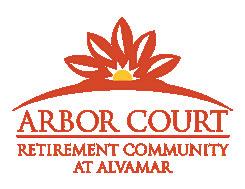


EDUCATION AND RECREATION
ADULT LEARNING CENTER
785.832.5960 usd497.org
DOUGLAS COUNTY EXTENSION OFFICE
785.843.7058 douglas.ksu.edu
INDEPENDENCE, INC.
785.841.0333 independenceinc.org
KAW VALLEY BRIDGE CLUB
785.838.3196 kawvalleybridge.wordpress.com
KAW VALLEY QUILTERS GUILD kawvalleyquiltersguild.org
LAWRENCE ARTS CENTER
785.843.2787 lawrenceartscenter.org
LAWRENCE CIVIC CHOIR lawrencecivicchoir.org
LAWRENCE MEMORIAL HOSPITAL
785.840.3072 lmh.org
LAWRENCE PARKS & RECREATION
785.832.7920 lawrenceks.org/lprd/home
OSHER LIFELONG LEARNING INSTITUTE
913.897.8530 osher.ku.edu
SENIOR RESOURCE CENTER FOR DOUGLAS COUNTY
785.842.0543 yoursrc.org
VINTAGE PLAYERS
THEATRE LAWRENCE SENIORS TROUPE theatrelawrence.com/vintage-players
EMERGENCY SERVICES AND UTILITY ASSISTANCE
AMERICAN RED CROSS
785.843.3550 redcross.org/local/kansas
BALLARD COMMUNITY CENTER
785.842.0729 ballardcenter.org
DOUGLAS COUNTY ECKAN
785.841.3357 eckan.org
HOUSING AND CREDIT COUNSELING, INC.
785.234.0217 housingandcredit.org
INDEPENDENCE, INC.
Fiscal Management Services for Frail/Elderly Medicaid Waiver
785.841.0333 independenceinc.org
LAWRENCE - DOUGLAS COUNTY HOUSING AUTHORITY
785.842.8110 ldcha.org
SOCIAL SECURITY
800.772.1213
ssa.gov
FOOD RESOURCES
CHAMPSS MEAL PROGRAMS (JAYHAWK AREA AGENCY ON AGING)
785.235.1367 jhawkaaa.org
JUBILEE CAFÉ fumclawrence.org/jubilee
JUST FOOD
785.856.7030 justfoodks.org
L.I.N.K. (LAWRENCE INTERDENOMINATIONAL NUTRITION KITCHEN) linklawrence.org
LAWRENCE MEALS ON WHEELS
785.830.8844 lawrencemow.org
GRIEF AND LOSS SUPPORT
MIDLAND CARE
785.232.2044 midlandcare.org
RUMSEY-YOST FUNERAL HOME AND CREMATORY Aftercare and Grief services
785.843.5111 rumsey-yost.com
HEARING
KANSAS COMMISSION FOR THE DEAF AND HARD OF HEARING (KCDHH)
785.368.8034
785.246.5077 (videophone) kcdhh.ks.gov
MENTAL HEALTH SERVICES
BERT NASH COMMUNITY MENTAL HEALTH CENTER
785.843.9192 bertnash.org
HEADQUARTERS KANSAS KANSAS SUICIDE PREVENTION
785.841.2345 or 988 hqkansas.org
RESOURCE CENTERS
CENTRO HISPANO RESOURCE CENTER
785.843.2039
DOUGLAS COUNTY LEGAL AID SOCIETY (785) 864-5564 lawrenceks.org/attorney/ legal_aid
INDEPENDENCE, INC.
785.841.0333 independenceinc.org
JAYHAWK AREA AGENCY ON AGING
785.235.1367
TDD/TYY: 800.766.3777 jhawkaaa.org
LAWRENCE PUBLIC LIBRARY
785.843.3833 lplks.org
SENIOR RESOURCE CENTER FOR DOUGLAS COUNTY (SRC)
785.842.0543 yoursrc.org
TAX ASSISTANCE AARP TAX AIDES
785.842.0543 yoursrc.org
RESOURCES FOR INDEPENDENT LIVING
MIDLAND CARE
785.232.2044 midlandcare.org
PROJECT LIFESAVER
Douglas County Sheriff’s Department
785.832.5204 dgso.org
TRINITY IN-HOME CARE
785.842.3159 tihc.org
VISITING NURSES
785.843.3738 kansasvna.org
TRANSPORTATION
LAWRENCE TRANSIT SYSTEM
TRANSIT ON DEMAND
785.312.7054 lawrencetransit.org.on-demand
SENIOR WHEELS
785.727.7876 yoursrc.org/senior-wheels
VETERANS AFFAIRS
KANSAS COMMISSION ON VETERANS AFFAIRS
785.296.3976 kcva.ks.gov
LAWRENCE VA CLINIC
800.574.8387 ext. 54650
U.S. DEPARTMENT OF VETERANS AFFAIRS
800.827.1000 va.gov
WEATHERIZATION
CITY OF LAWRENCE NEIGHBORHOOD RESOURCES DEPARTMENT
785.832.7700
lawrenceks.org/pds/housing_ programs




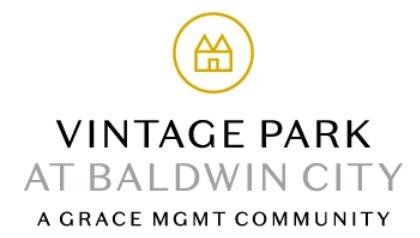






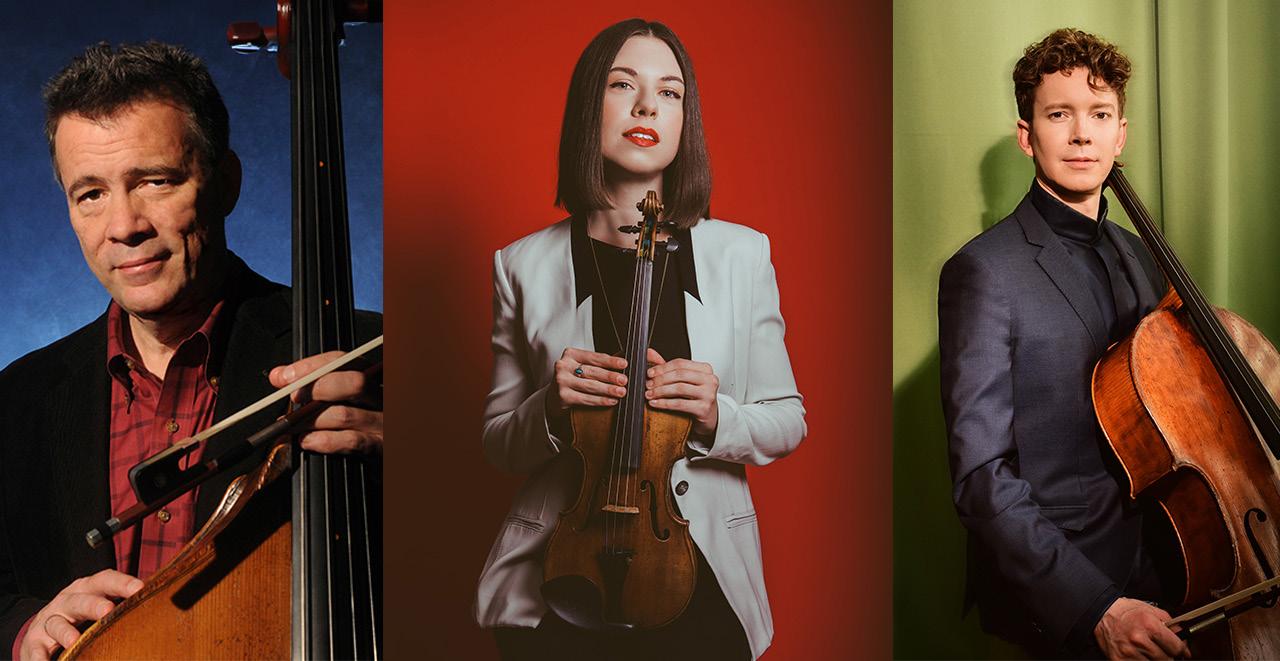


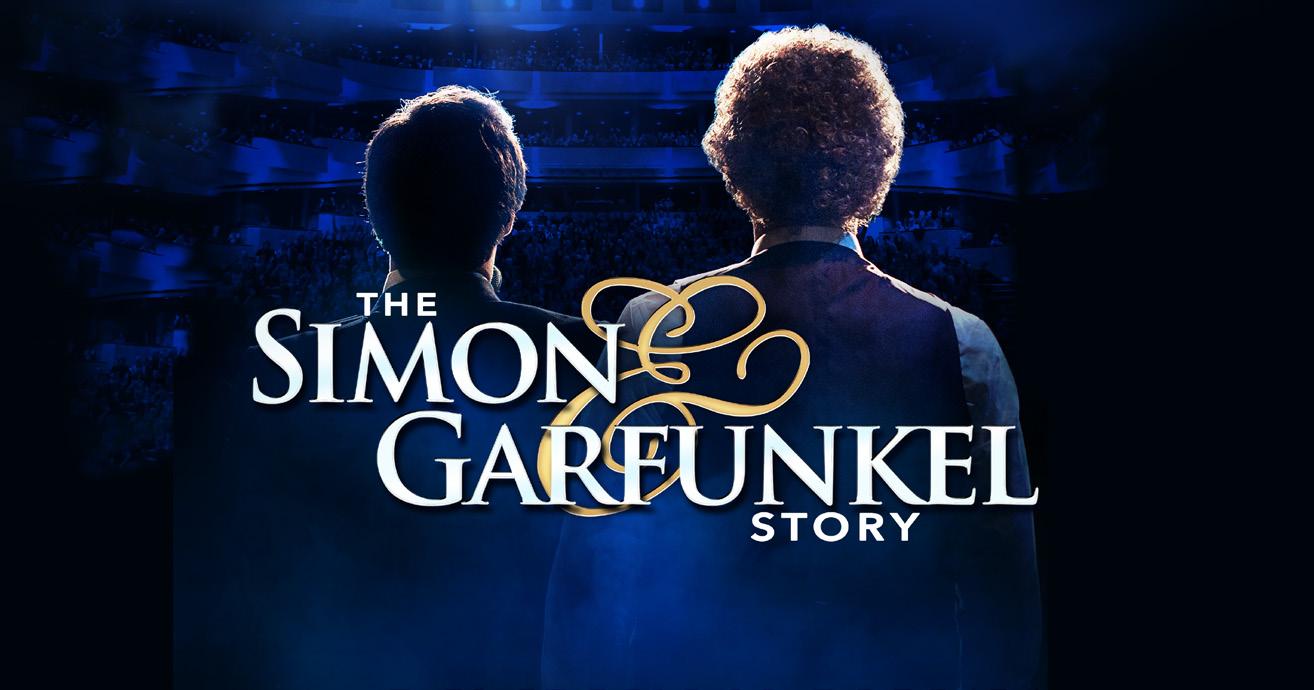
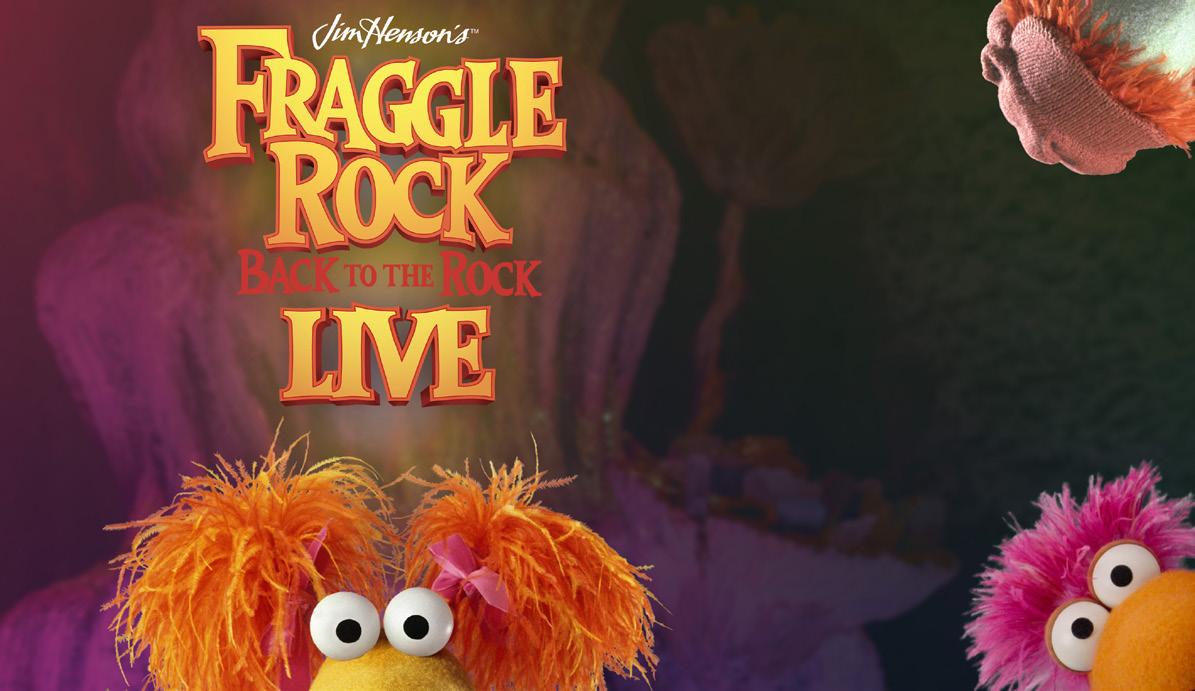
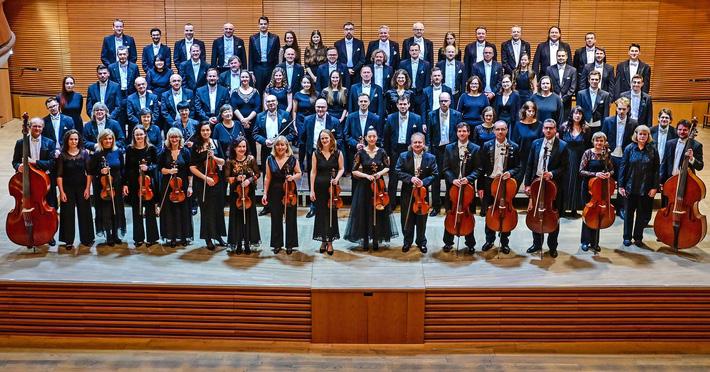




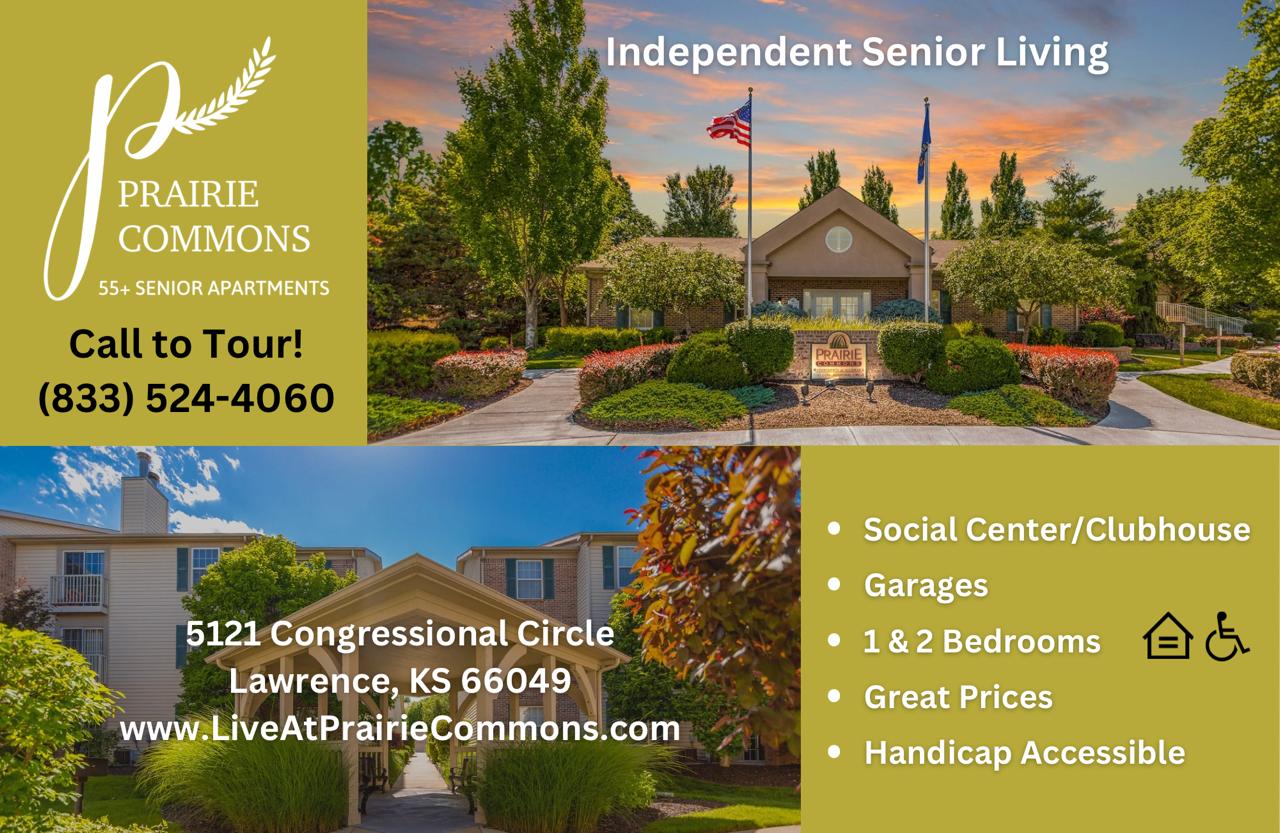

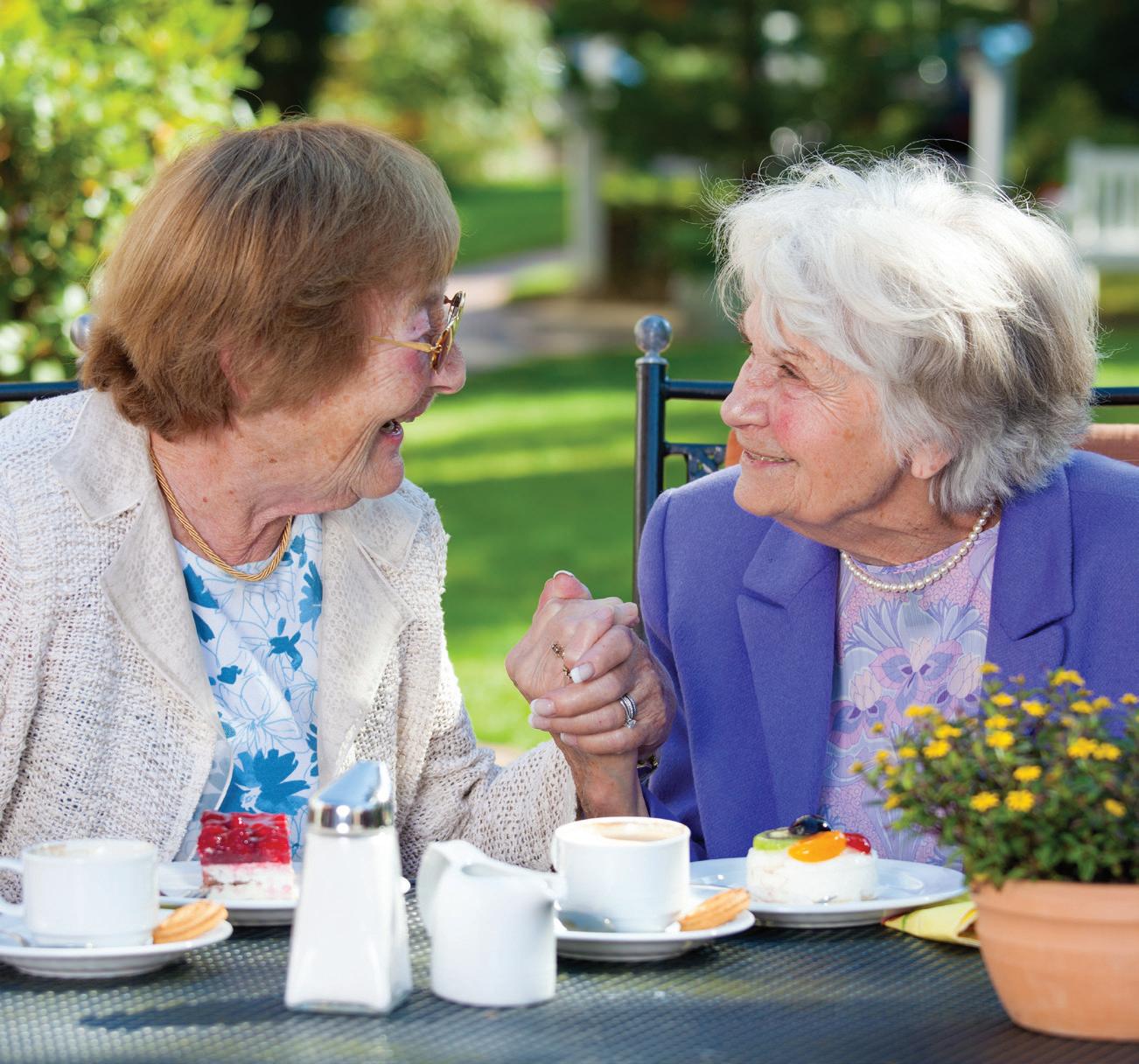
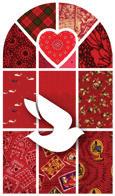
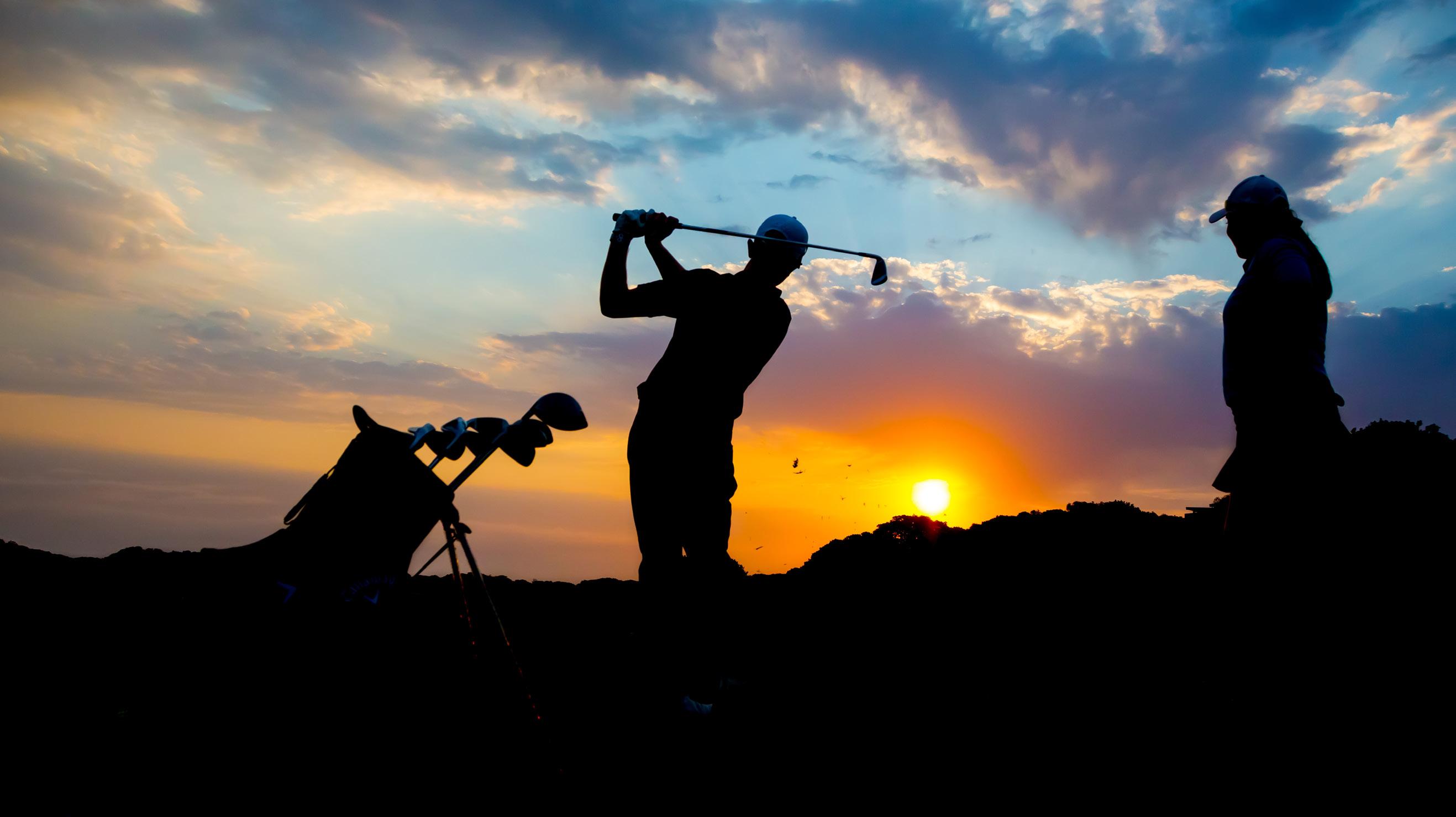
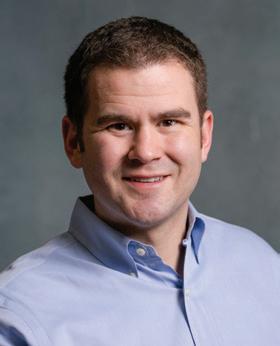

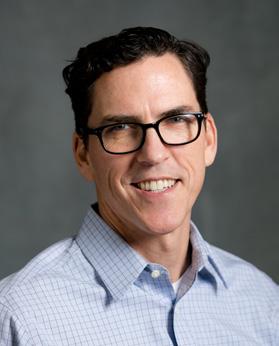

Whatever your goals are for staying active, they certainly don’t involve persistent joint pain – or a long drive to see a joint specialist. At LMH Health OrthoKansas, we’ll relieve you of both. As the area’s only orthopedic center offering a
comprehensive approach to joint health, four of our nine physicians have elite training and extensive experience in joint replacement surgery, delivering the latest techniques, technologies and expertise right to you.
Choose the orthopedic team that will keep you driving toward your goals, not toward out-of-town care: 785-843-9125 or lmh.org/healthyjoints